
Oil analysis is a necessary component in machine health and longevity. Accurate oil analysis can provide valuable information regarding your lubricant’s cleanliness, levels of additives, and degree of wear. Regular oil testing allows you to track trends in data over time, which helps you recognize changes that indicate impending damage or failure is looming.
Studies have shown that improper lubrication leads to:
- 43% of mechanical failures
- 54% of bearing failures
- 50% of roller bearing damage
- 70% of equipment failures
The procedures used to collect and handle an oil sample play a critical role in getting accurate test results. A contaminated oil sample will skew the test results, making the information you receive unreliable. To ensure you are using proper sampling procedures, avoid these six common ways to mess up gathering and handling an oil sample:
1. The Equipment Was Not Running
Oil analysis is often required to determine the state of the oil as it runs through the equipment. To gain an accurate analysis, the oil sample must represent the lubricant in the machine during normal working conditions.
If the machine or equipment is sampled "cold", or while the machine is idle, this is not a true representation of the state of the oil during operation. The best way to ensure an accurate sample under normal working condition is sampling while the equipment is running and after it has reached its normal operating temperature.
2. The Equipment Was Not At Optimal Temperature
Sometimes due to safety restrictions or machinery set-up, it is not possible to sample while the equipment is running. There are still guidelines to follow which allow for an uncorrupted sample for analysis.
A similar situation to sampling equipment that is not running, samples from equipment that is not at the normal operating temperature will not give accurate data. Running the machine for at least an hour and taking the sample within 10-15 minutes of shut down is the best way to avoid taking a sample that is below the optimal temperature.
3. Sample Taken From Bottom of Reservoir
Sampling location is an important factor for accurate analysis. The source of the sample can greatly affect the outcome of any testing. Oil at the bottom of the reservoir often contains sediment or other debris that is not necessarily representative of the oil running through the equipment.
Analysis of this oil might indicate the machine is in worse shape than it actually is. Proper sampling from the reservoir, close to the gear set or return line, will provide truer data.
4. Sample Taken Downstream from Filter
This is another example of a poor location choice for oil sampling. Any sample taken downstream from the filter provides skewed results. The oil in this location has passed through the filtration system, eliminating many large particles and contaminants.
Samples from this location give inaccurate data regarding debris and are not true representations of the quality of the oil as it pumps through the equipment.
5. Improper Sample Storage
A very important step in preventing contamination of samples is maintaining clean sampling hardware and containers. One thing that is often overlooked is proper lid placement for samples. Make sure the sample container is clean and that the lid is tight but not too tight.
Waiting too long to lid the sample jar or improper placement of the lid are both preventable causes of contamination. Leakage of the sample could also cause delay or inaccurate analysis.
6. Improperly Flushed Sampling Hardware
As stated previously, properly maintained sampling hardware is necessary to get accurate testing results. To ensure less contamination and higher accuracy in analysis, flushing sample lines and properly cleaning containers is essential. Contamination also occurs through improper placement techniques or using damaged sampling equipment.
Cross-contamination from improperly flushed lines, improper placement techniques, and damaged or dirty sampling equipment will result in skewed results. A flawed sample leads to a flawed analysis, and so the problem-solving approach is flawed, as well.
There are many ways to mess up oil sampling. Most involve preventable causes such as sampling location, placement techniques, or maintenance of sampling equipment. For a more accurate oil analysis every time, follow sampling guidelines and keep sampling equipment clean. Look here for more tips to keep your equipment moving smoothly. For information about oil contamination testing or establishing a lubrication maintenance plan, contact us.








